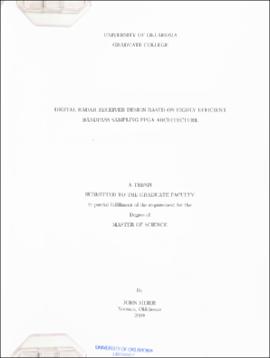| dc.contributor.author | Meier, John | |
| dc.date.accessioned | 2021-02-15T18:00:15Z | |
| dc.date.available | 2021-02-15T18:00:15Z | |
| dc.date.created | 2009 | |
| dc.date.issued | 2009 | |
| dc.identifier.uri | https://hdl.handle.net/11244/328591 | |
| dc.description | Thesis (M.S.)--University of Oklahoma, 2009. | |
| dc.description | Includes bibliographical references (leaves 62-64). | |
| dc.description.abstract | As digital electronics become faster and more efficient, it becomes possible to move the analog/digital interface in a radar downconversion system further towards the antenna. Instead of digitizing radar echoes at the end of the down-conversion process, digital logic can perform the same operations previously performed by analog components. Taking full advantage of this opportunity will result in a more highly integrated and reconfigurable design. By removing unnecessary analog components, the error from component variability and noise injected into the signal of interest is reduced, the size of the receiver and the power required for operation is minimized, and the overall cost of the system can be lowered. This research is focused on employing software defined radio concepts for weather observation, thus creating a low-cost digital radar receiver at the University of Oklahoma for use in radar projects as a way of obviating the need for commmercial radar receivers, which can be many times more expensive. Software-defined radio techniques, such as bandpass sampling, are used to achieve a high data processing bandwidth and oversampling ratio with the smallest logic resource utilization.
Two novel digital receiver designs are discussed in this thesis. A prototype compact single-channel digital receiver based on a 14-bit analog-to-digital converter and a hand-solderable Xilinx FPGA was built and tested both in the laboratory and at the National Weather Radar Testbed (NWRT). Building on the lessons learned from testing the single-channel digital radar receiver, a second digital receiver was designed for expanded capabilities. Through the utilization of a low-power, simultaneous-sampling eight channel ADC with high-speed serial data links and a cost-efficient FPGA with integrated DSP slices, eight data channels can be digitized, processed and transferred at the same time in a compact form factor. An ethernet interface has been included which allows for a scalable control channel so that the digital receiver's operations can be quickly modified. This also makes it possible to remotely change the firmware of the FPGA in seconds, without the need for physical access. Development of host computer platforms to store and process each digital receiver's output are also discussed. | |
| dc.format.extent | x, 81 leaves | |
| dc.format.medium | x, 81 leaves : ill. (some col.), col. maps ; 29 cm. | |
| dc.language.iso | eng | |
| dc.subject.lcsh | Signal processing--Digital techniques | |
| dc.subject.lcsh | Field programmable gate arrays | |
| dc.subject.lcsh | Remote sensing | |
| dc.subject.lcsh | Radar meteorology | |
| dc.subject.lcsh | Electric filters, Bandpass | |
| dc.title | Digital radar receiver design based on highly efficient bandpass sampling FPGA architecture | |
| dc.type | Text | |
| dc.contributor.committeeMember | Tull, Monte | |
| dc.contributor.committeeMember | Palmer, Robert | |
| dc.contributor.committeeMember | Yeary, Mark | |
